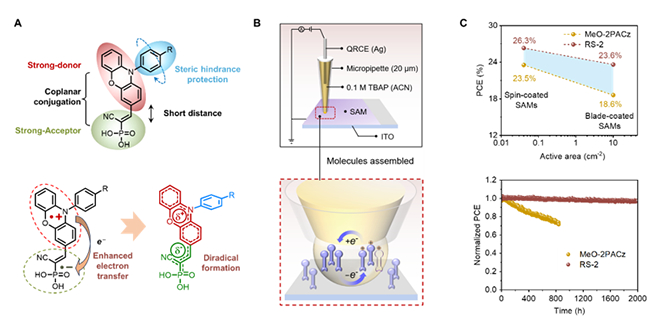Progress Achieved by Chinese Scholars in the Development of Novel Diradical Self-Assembled Molecular Transport Materials

Figure. (A) Design strategy for diradical self-assembled molecules; (B) schematic illustration of in situ characterization of self-assembled molecules using scanning electrochemical cell microscopy–thin-layer voltammetry; (C) comparison of the efficiencies of perovskite solar cells and minimodules based on conventional self-assembled molecule MeO-2PACz and novel diradical self-assembled molecule RS-2, as well as comparison of device stability under maximum power point operation
With the support of the National Natural Science Foundation of China (Grant Nos. T2425022, 22204159, 22075277, 22109156), Profs. Chuanjiang Qin, Lixiang Wang, Min Zhou, and associate professor Dezhong Zhang from the Changchun Institute of Applied Chemistry, Chinese Academy of Sciences, have successfully developed organic self-assembled hole transport molecules with diradical characteristics. This achievement was made possible through a design strategy based on strong donor-acceptor conjugation and spatial steric hindrance regulation, leading to breakthroughs in the efficiency, stability, and large-area processability of perovskite photovoltaic devices. The related research results, entitled “Stable and uniform self-assembled organic diradical molecules for perovskite photovoltaics,” were published in Science on 27 June 2025. Paper link: https://www.science.org/doi/10.1126/science.adv4551.
Driven by the global “dual carbon” strategy, perovskite solar cells have become a significant focus for clean energy research. However, the commonly used organic self-assembled hole transport materials in perovskite solar cells still face numerous challenges, primarily insufficient carrier transport capacity, poor chemical stability, and difficulties in achieving large-area solution processing. While traditional design strategies for improving the performance of self-assembled molecules can enhance conductivity and stability through increased electron delocalization, they can also leadsin molecular aggregation during solution processing, resulting in poor uniformity of the formed self-assembled films and increased process complexity.
To address these challenges, the research team introduced an innovative diradical self-assembly molecular design strategy. By designing a coplanar donor–acceptor conjugated structure, they achieved strong diradical characteristics in self-assembled small molecules for the first time, significantly boosting the electrical conductivity of molecules. Simultaneously, spatially hindered groups were incorporated into the molecular structure, effectively stabilizing the diradical properties and substantially increasing the dimerization energy. This prevented molecular stacking, making it easier to achieve large-area uniform film formation during self-assembly. As a result, the diradical self-assembled molecules achieved a combined optimization of carrier mobility, chemical stability, and solution processability.
To verify the performance advantages of these molecules, the team leveraged interdisciplinary research expertise to develop a state-of-the-art super-resolution electrochemical microscopy characterization system. Coupled with scanning electrochemical cell microscopy and thin-layer voltammetry techniques, this system enabled, for the first time, electrochemical characterization of the micro-regions of self-assembled molecular layers in perovskite photovoltaic devices. This approach allowed precise measurement of the carrier transfer rate, assembly density, and distribution uniformity of the self-assembled molecules, revealing the distinct advantages of diradical molecules in terms of interfacial charge transport properties, chemical stability, and large-area processing uniformity. The technology provides in situ, high-precision, and multidimensional analytical capabilities for the performance evaluation of self-assembled molecules, offering technical support for the development of highly efficient and stable interface transport materials.
The perovskite solar cells developed by the team demonstrated impressive results in device efficiency, operational stability, and the feasibility of modules and tandem devices, confirming the practical application potential of the new diradical self-assembled molecules. Among these, the small-area perovskite solar cells achieved an efficiency of 26.3%, while micro-module efficiency reached 23.6%. Upon upscaling, efficiency loss was minimized, and device operational stability markedly improved. In collaboration with Zhenguo Li and Bo He’s team at Longi Green Energy Central Research Institute, the perovskite-silicon tandem devices achieved an efficiency of 34.2%, certified by the US National Renewable Energy Laboratory. This body of work introduces new materials and technologies to enhance perovskite solar cell performance and propels the further industrialization of perovskite photovoltaics.
Contact Us

National Natural Science Foundation of China
Add: 83 Shuangqing Rd., Haidian District, Beijing, China
Postcode: 100085
Tel: 86-10-62327001
Fax: 86-10-62327004
E-mail: bic@nsfc.gov.cn
